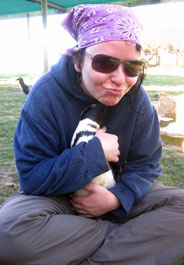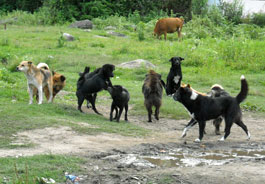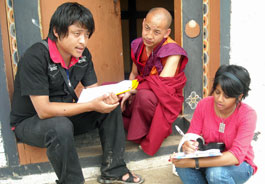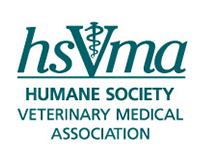HSVMA Students Travel the World to Help Animals
For these veterinary students, the end of the 2010 spring semester didn’t give way to a relaxing summer of fun, but it did include a unique opportunity to put their skills and passion for animals to use in South Africa, Bhutan and Mexico.
Claire Rice—Class of 2012, University of Georgia
Studying Penguins in South Africa
 Claire and African penguin, Adri, a permanent inhabitant of the Penguins Eastern Cape Rehab, as she is blind and cannot be released. Michaelle Purdee/UGA CVMIt was imperative that I did something fulfilling during my last free summer before starting clinical rotations and getting a job in the "real world." I had only two requirements—I wanted to go abroad and I wanted to work with animals, preferably wildlife.
Knowing that I wanted to pursue conservation medicine and wildlife rehabilitation when I graduated, when an opportunity arose to join a close friend and classmate in South Africa to study hemoparasites and gastrointestinal parasites in penguins, I knew it was the perfect opportunity.
For two months, we collected blood, guano and ectoparasites from African penguins (Spheniscus demersus) at the Eastern Cape Penguin Rehabilitation Center in Cape St. Francis. We also spent two weeks at the Southern African Foundation for the Conservation of Coastal Birds (SANCCOB) in Cape Town, collecting samples from 66 abandoned, juvenile Cape gannets (Morus capensis), most of whom were successfully released.
While both facilities successfully focus on the rescue, rehabilitation and release of marine birds, there were numerous differences between the two, and I came to understand which formulas worked well and which ones could use improvement. But the common thread in both facilities was how much the workers—veterinarians and staff alike–cared for the animals; it was exactly the kind of environment that I want to create in my future work place.
Ultimately, we were unable to collect a sufficient number of samples from the penguins to complete the research as planned, but we modified the scope of the project to utilize samples collected from other marine birds (science rarely goes the way that you expect!). Regardless, I had some amazing experiences this summer—drawing blood from penguins, gannets, cormorants, and other birds; seeing amazing sites, including Kruger National Park and Addo Elephant National Park; meeting incredible people; climbing Table Mountain and swimming in the Indian Ocean; and even cheering for a couple of soccer games and blowing on a vuvuzela.
The summer was definitely fulfilling and reminded me once again why I chose this amazing profession—there are so many directions that it can take you.
Mehnaz Aziz—Class of 2011, Tufts Cummings School of Veterinary Medicine
Humane Dog Population Control in Bhutan
 The program in Bhutan focuses on humanely controlling the free-roaming dog population, reducing rabies incidences, and advancing animal welfare and responsible pet ownership. Mehnaz AzizThis past summer I had the incredible fortune of visiting the Himalayan nation of Bhutan. With the financial support of HSVMA, Humane Society International (HSI), and my mentor at Tufts Cummings Veterinary School, Dr. Gretchen Kaufman, I was able to spend a month in Bhutan to conduct research for HSI. HSI is currently conducting a 3-year catch-neuter-vaccinate-release (CNVR) program for the dogs in Bhutan with the goals of humanely controlling the free-roaming dog population, reducing rabies incidences, and advancing animal welfare and responsible pet ownership.
Humane dog population control is of a different dynamic in Bhutan because of the country’s many unique traits: the mountainous, largely rural and untouched landscape; the strong Buddhist background; the small human population of 700,000 with a free-roaming dog population of nearly 60,000; the fact that the country is surrounded by India and China—both of which have rabies control challenges of their own; and finally the fact that Bhutan does not have a formal veterinary school and only 20 official veterinarians exist in the country.
In congruence with their Buddhist background, in 2009 the Royal Government of Bhutan requested HSI to assist in controlling their free-roaming dog population and associated rabies incidences in a humane manner. Three HSI teams situated in different districts across Bhutan have, through June 2010, sterilized over 11,000 dogs. Not only do they sterilize stray and owned dogs, they also treat dogs for transmissible venereal tumors, pyometra, mange and any other health condition they are presented with.
 Mehnaz Aziz interviews two Bhutan residents about the free-roaming dog population. Dr. Rajesh Kumar Pandey/HSIThe purpose of my research was to evaluate the progress of HSI’s work through the perspective of local community members and public officials. I was also interested in assessing how HSI’s project is influencing human attitude and behavior towards free-roaming dogs. I interviewed 355 community members and 20 public officials throughout the country, and although my data analysis is still in its early phases, some of the general observations I hope to expand on in my official report include: 1) The majority of community members and public officials believe there is a noticeable decrease in the number of puppies in the districts that HSI has conducted its program, 2) They also believe that the dog population that remains on the streets looks healthier because of HSI’s project, and 3) Nearly everyone I spoke with commended HSI’s professionalism and skill, and hope that HSI will continue to work in Bhutan beyond their 3-year commitment.
Even in light of such progress and positive observations, HSI still faces many challenges in creating a sustainable dog population and rabies control program in Bhutan. More work in advancing animal welfare and humane education is needed, and Bhutan is in need of a more permanent veterinary clinic or shelter where injured and sick animals can be treated and cared for over the long term. As HSI continues their work in Bhutan, they will hopefully be able to collaborate with local animal welfare organizations to expand the care and welfare of animals throughout Bhutan. Through HSI’s work, I am optimistic that Bhutan will become a paradigm of how an international NGO can team up with a government to implement effective humane dog population and rabies control.
Jaimi Johnson—Class of 2012, University of Minnesota
ViDAS in Mexico
In July 2010, I volunteered with the ViDAS organization (International Veterinarians Dedicated to Animal Health) on a sterilization campaign in Playa del Carmen, Mexico, joining a team of veterinary students, veterinarians, technicians, and local volunteers in a clinic set up in a kindergarten school. This year’s campaign set a new ViDAS record, with 758 cats and dogs being sterilized in six days. While the majority of the animals brought to the clinic were pets, we also sterilized many street dogs and cats, including several feral cats living near the houses we stayed in.
The experience provided me with insight into the cultural competencies associated with providing veterinary care to underserved populations, as well as the skills associated with conducting physical examinations and assisting with spay/neuter surgeries and anesthesia. I learned first-hand about the importance of sustainable endeavors that partner with local communities to provide high-quality veterinary care as a way to humanely address the issue of animal overpopulation.
Check out the international volunteer opportunities HSVMA Field Services has to offer here. Openings are still available for Peru in 2011. |



